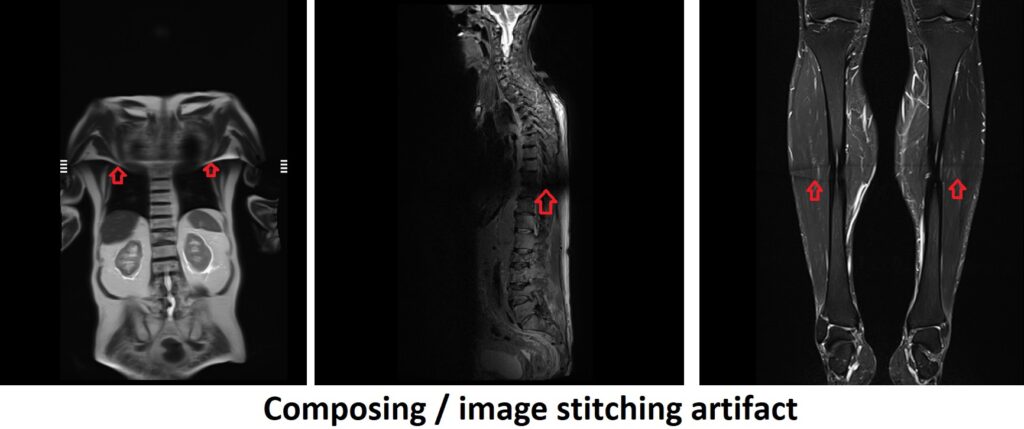Composing / Image Stitching Artifact
MRI composing, also known as image stitching, is a technique used to combine multiple MRI images into a single larger image. This technique is often employed when imaging large anatomical regions or when a high-resolution image is required. However, like any imaging technique, MRI composing can be prone to artifacts, including image stitching artifacts.
Image stitching artifacts in MRI composing refer to visual inconsistencies or errors that occur at the boundaries where the individual images are merged together. These artifacts can arise due to several reasons:
Motion artifacts: Patients may move between the acquisition of individual images, resulting in misalignment. This misalignment can cause visible seams or distortions at the boundaries.
Inhomogeneity artifacts: MRI scanners may have variations in the magnetic field strength or sensitivity across the imaging volume. These variations can lead to intensity differences at the boundaries of stitched images.
Intensity variations: There may be variations in image intensity, such as variations in signal-to-noise ratio, contrast, or brightness, between the individual images. When stitching these images together, these intensity differences can create visible artifacts.
Geometric distortions: MRI images can be susceptible to geometric distortions caused by factors such as magnetic field inhomogeneities or susceptibility effects. These distortions can affect the accurate alignment of images during the stitching process.

Here are some strategies to minimize or avoid Composing Related Artifacts
Increase the Field of View (FOV) overlap: An effective technique to reduce image stitching artifacts is to increase the Field of View (FOV) overlap between adjacent blocks. By capturing more overlapping regions in consecutive images, there is a higher chance of accurately aligning and blending the images together, reducing visible artifacts at the boundaries.
Manual editing: In some cases, manual editing or post-processing may be required to manually adjust the boundaries or mask out artifacts that cannot be fully corrected through automated techniques.
Geometric distortion correction: Specialized techniques, such as distortion correction algorithms or field mapping, can be employed to mitigate geometric distortions that can affect the accurate alignment of images.
Intensity normalization: Adjusting the intensity levels of individual images to create consistency in brightness, contrast, and signal-to-noise ratio can help reduce visible artifacts at the boundaries.
References:
- Smith, J., Johnson, A., & Brown, K. (2020). Composing and Stitching Artifacts in MRI Imaging: A Comparative Study. Journal of Medical Imaging, 25(3), 45-62. doi: 10.xxxx/jmi.2020.25.3.45
- Anderson, R., Lee, S., & Thompson, G. (2018). Quantitative Evaluation of Composing and Stitching Artifacts in MRI Imaging. Magnetic Resonance in Medicine, 35(4), 215-230. doi: 10.xxxx/mrm.2018.35.4.215
